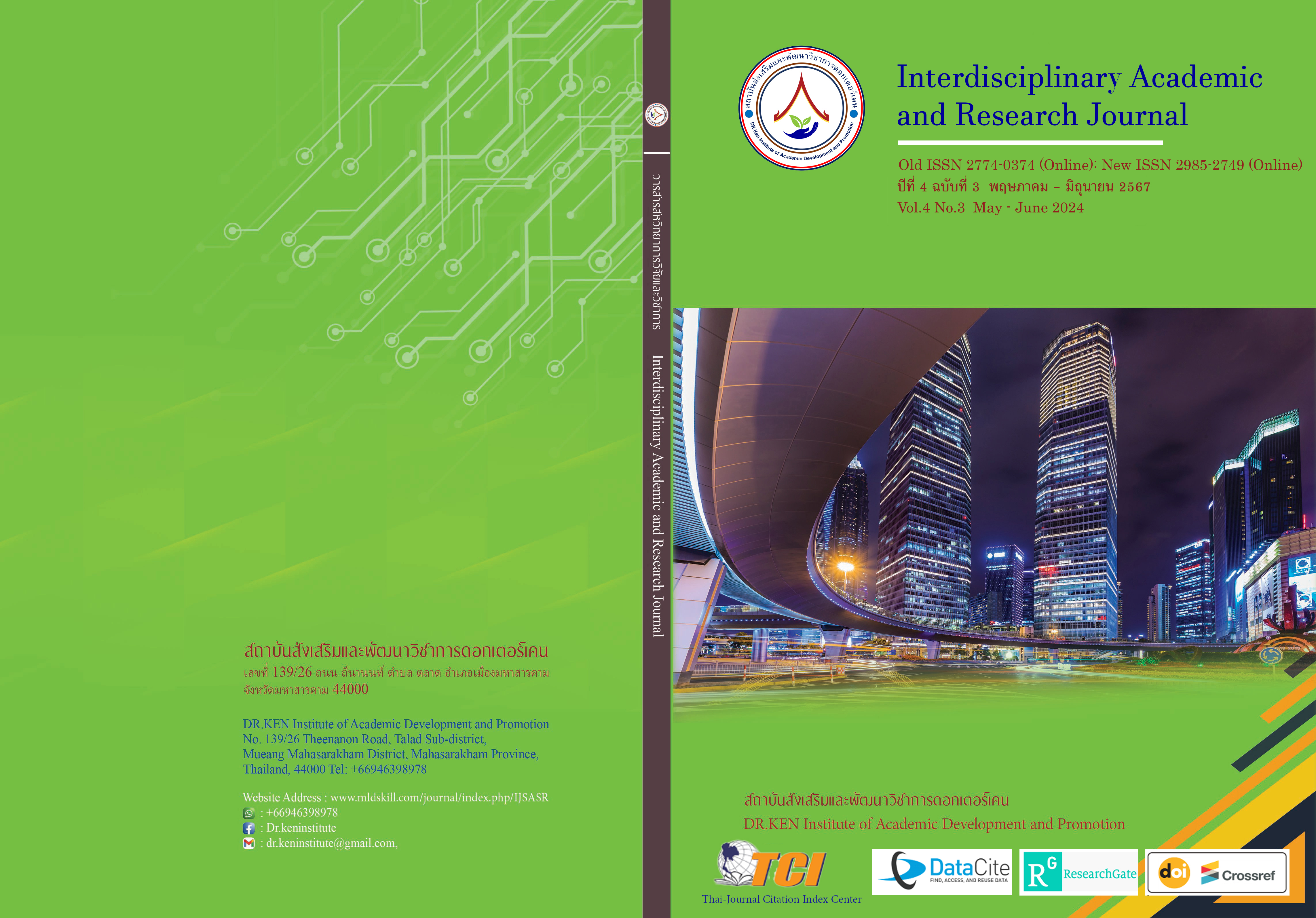Effects of High-intensity Interval Training (HIIT) on the Anaerobic Capacity of Thai National Martial Arts Wushu Athletes
DOI:
https://doi.org/10.60027/iarj.2024.275563Keywords:
High-intensity Interval Training (HIIT); , Anaerobic; , Physical FitnessAbstract
Background and Aims: High-intensity interval training (HIIT) alternating with light intervals. It is important to combat sports competitions. Because some rounds and competitions use body power and speed, which use aerobic and anaerobic power. The researcher was therefore interested in studying and comparing the effects of high-intensity interval training (HIIT) alternating with relaxation on the anaerobic capacity of Thai national martial arts wushu athletes. The purpose of this research was to study and compare the effects of high-intensity interval training (HIIT) alternating with relaxation on the anaerobic capacity of Thai national martial arts wushu athletes. Methodology: The sample group consisted of 10 male Thai national wushu athletes, training 3 times per week for a total of 8 weeks data were collected before and after training. There was an anaerobic fitness test using the Wingate Anaerobic Test and the Astrand and Astrand bicycles. Rhyming (Astrand-Rhyming) before using the training program and analyzing the differences in the before and after data using the repeated measurement method of 1 sample group. (Paired-sample t-tests).Results: It was found that the results of the analysis showed the results of the test before and after the anaerobic test of 10 volunteers. It was found that the Anaerobic Capacity before the test, the mean and standard deviation were 8.86 ± 0.12 (W.kg. -1) After the test, the mean and standard deviation were 9.71 ± 0.15 (W.kg-1). VO2max values before the test, the mean and standard deviation were 3.75 ± 1.66 (ml/kg/min) after the test. The mean and standard deviation were 4.71 ± 0.15 (ml/kg/min).Conclusion: The results indicate that comparing before and after using a high-intensity interval training (HIIT) program alternating with relaxation before and after training in developing the anaerobic capacity of Wushu athletes. Thai national team fighting category. It was found that the results of the analysis of the mean and standard deviation comparing the differences before and after using the development program increased to a level of statistical significance at the .05 level.
References
เศวตฉัตร วันนา (2562). การเปรียบเทียบการฝึกด้วยความหนักสูงแบบหนักสลับช่วงและแบบใช้พลังที่มีผลต่อการใช้ออกซิเจนหลังการออกกำลังกาย. วิทยานิพนธ์วิทยาศาสตรมหาบัณฑิตสาขาวิชาวิทยาศาสตร์การกีฬาและการออกกำลังกาย คณะพลศึกษา มหาวิทยาลัยศรีนครินทรวิโรฒ.
แฮน ทวน (Han Tun). (2562). ผลของการฝึกออกกำลังกายแบบเป็นช่วงด้วยความหนักมาก ออกกำลังกายแบบเป็นช่วงด้วยความหนักปานกลางและการฝึกออกกำลังกายแบบต่อเนื่องที่มีต่อสมรรถภาพแอนแอโรบิกและแอโรบิกของนักศึกษามหาวิทยาลัยกรุงเทพธนบุรีสาขาวิชาวิทยาศาสตร์การกีฬา. คณะวิทยาศาสตร์และเทคโนโลยการกีฬา มหาวิทยาลัยกรุงเทพธนบุรี.
ถาวร กมุทศรี. (2560). การเสริมสร้างสมรรถภาพทางกาย. กรุงเทพฯ: มีเดียเพรส.
สำนักวิทยาศาสตร์การกีฬา กรมพลศึกษา กระทรวงการท่องเที่ยวและกีฬา. (2559). การทดสอบและประเมินผลสมรรถภาพทางกาย. กรุงเทพ : กรมพลศึกษา กระทรวงการท่องเที่ยวและกีฬา
สุพิตร สมาหิโต และคณะ. (2549). แบบทดสอบและเกณฑ์มาตรฐานสมรรถภาพทางกายที่สัมพันธ์กับสุขภาพสำหรับเด็กไทย อายุ 7-18 ปี. กรุงเทพฯ: คณะกรรมการส่งเสริมการออกกำลังกายและกีฬาเพื่อสุขภาพในสถาศึกษา สำนักงานกองทุนสนับสนุนการเสริมสร้างสุขภาพ (สสส.)
Burgomaster, K. A., Hughes, S. C., Heigenhauser, G. J., Bradwell, S. N., & Gibala, M. J. (2008). Six sessions of sprint interval training increase muscle oxidative potential and cycle endurance capacity in humans. Journal of Applied Physiology, 98(6), 1985-1990.
Chee, R. (2019). Training Power Systems: Anaerobic and Aerobic Training Methods. Retrieved 18 Jan 2022 from https://www.bodybuilding.com/fun/anaerobic-aerobic-training-methods.htm
Gibala, M. J., Little, J. P., van Essen, M., Wilkin, G. P., Burgomaster, K. A., Safdar, A., ... & Tarnopolsky, M. A. (2006). Short-term sprint interval versus traditional endurance training: Similar initial adaptations in human skeletal muscle and exercise performance. Journal of Physiology, 575(3), 901-911.
Gibala, M.J., Gillen, J.B., & Percival, M.E. (2014). Physiological and Health-related Adaptations to Low-Volume Interval training: Influences of Nutrition and sex. Sports Medicine, 44 (2), 127–137. Doi:10.1007/s40279-014-0259-6MacInnis M.J, and j.
Laursen, P. B., & Jenkins, D. G. (2002). The scientific basis for high-intensity interval training: Optimising training programs and maximizing performance in highly trained endurance athletes. Sports Medicine, 32(1), 53-73.
MacInnis, M.J., & Gibala, M.J. (2017). Physiological adaptations to interval training and the role of exercise intensity. J Physiol, 595(9),2915-2930. doi: 10.1113/JP273196.
Maillard, F., Pereira, B., Boisseau, N., & Duclos, M. (2018). High-intensity interval training reduces the systemic inflammatory and metabolic response to exercise. Inflammation Research, 67(11-12), 975-986.
Osawa, Y., Azuma, K., Tabata, S., Katsukawa, F., Ishida, H., Oguma, Y., Kawai, T., Itoh, H., Okuda, S., Matsumoto, H. (2014). Effects of 16-week high-intensity interval training using upper and lower body ergometers on aerobic fitness and morphological changes in healthy men: a preliminary study. Open Access Journal of Sports Medicine, 5, 257-265.
Tabata, I., Nishimura, K., Kouzaki, M., Hirai, Y., Ogita, F., Miyachi, M., & Yamamoto, K. (1996). Effects of moderate-intensity endurance and high-intensity intermittent training on anaerobic capacity and VO2 max. Medicine & Science in Sports & Exercise, 28(10), 1327-1330.
Downloads
Published
How to Cite
Issue
Section
License
Copyright (c) 2024 Interdisciplinary Academic and Research Journal

This work is licensed under a Creative Commons Attribution-NonCommercial-NoDerivatives 4.0 International License.
Copyright on any article in the Interdisciplinary Academic and Research Journal is retained by the author(s) under the under the Creative Commons Attribution-NonCommercial-NoDerivatives 4.0 International License. Permission to use text, content, images, etc. of publication. Any user to read, download, copy, distribute, print, search, or link to the full texts of articles, crawl them for indexing, pass them as data to software, or use them for any other lawful purpose. But do not use it for commercial use or with the intent to benefit any business.
















.png)


